In his directorial style Dylan is heavily influenced by European art cinema. In a contemporary interview he stated that his favourite director was the great Spanish surrealist Luis Bunuel, whose startling films continually challenge the audience to examine the nature of ‘normal reality’. The dreamlike sequencing of the movie is a counter point to these performances of songs in which the dividing line between what is real and what is not real is uncertain. It is left to the viewer to decide where that borderline lies. But it is a borderline that is continually shifting. In Renaldo Dylan attempts to marry the scatological approach of directors like Bunuel, Jacques Rivette and the French New Wave directors with the substance of his own songs. Very little of the film appears to be scripted, despite playwright Sam Shepard being drafted in to follow the tour, supposedly as the movie’s ‘screen writer’. Its unconventional ‘cut up’ narrative also echoes the approach of the esteemed ‘Beat’ novelist William Burroughs. But Bunuel is perhaps the strongest influence on the film. Like many of Bunuel’s films, Renaldo is structured like a dream. Each scene connects to the others with surreal logic in a way that is sometimes reminiscent of Bunuel’s final production That Obscure Object of Desire (1977). In this film the beautiful young heroine – the ‘object of desire’ – is actually played by two different actresses. But the lustful middle aged leading man, played by Fernando Rey, never seems to notice this. Dylan takes this approach even further by switching the roles of all the characters around. In some ways all the men in the film represent different versions of Renaldo (who Dylan describes in the 1978 interview with Jonathan Cott as an ‘everyman’ figure) and all the women play different versions of Clara. Dylan takes this ‘shape shifting’ even further by merging elements of fiction and reality in a curiously offhand way. Actual footage from the tour, showing the band arriving at locations in their tour bus, the stage being set up and fans watching their arrivals, is also included.

Although some professional actors such as Harry Dean Stanton, Sam Shepard and Ronnee Blakely appear in dramatic roles, the majority of the ‘parts’ are played by members of Dylan’s touring band, few of whom are accomplished or professional actors. The often amateurish attempts of the musicians to act creates an unsettling effect. In one scene Mick Ronson has a bizarre exchange with veteran rock singer Ronnie Hawkins (who, according to the film’s titles, is appearing as ‘Bob Dylan’ whereas Dylan himself supposedly plays the part of ‘Renaldo’), refusing him entrance into a room. It is clear that neither musician really knows how to act and that the encounter is being improvised. Hawkins is also featured in a long spoken scene in which he attempts to persuade an ‘innocent’ young girl (Ruth Tyrangiel) to go on tour with him. At no point do we really believe that Hawkins is ‘Bob Dylan’.. Such scenes, especially when contrasted against the high level of professionalism of the concert footage, are rather jarring. We cannot fail to notice that the ‘actors’ are actually members of the Rolling Thunder entourage. And though the singer in whiteface on stage is also supposedly a fictional character, it is obvious that the person behind the ‘mask’ is actually Bob Dylan himself.
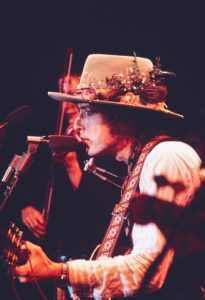
In the Cott interview Dylan states that …what we did was cut up reality and make it more real… and that …about a third was improvised, about a third is determined and about a third is blind luck… statements which could also be taken to refer to both the process of Dylan’s song writing and his onstage performances, with their emphasis on spontaneity and willingness to create ‘shifting texts’ centered on changing, ambiguous narrators. Although Renaldo may be – at least on first viewing – a rather mad jumble of events, after a few viewings its structure becomes clearer. We continually cut back to scenes in which folk singer David Blue laconically relates various tales of the ‘old days’ in Greenwich Village. This anchors the film in the reality of the history of Bob Dylan, who Blue never refers to as ‘Renaldo’. We also see various scenes filmed in a diner with ‘characters’ who seem to be ‘ordinary’ members of the public, one of whom frequently pays tribute to Bob Dylan as his hero. Dylan has referred to this character as the ‘Greek chorus’ of the film, but Blue’s scenes have a similar function. There are also diversions in which Dylan visits a Native American reservation and scenes filmed in Harlem in which the unseen interviewers ask various black people on the street their opinion s about the case of boxer Rubin Carter, who Dylan – through Desire’s memorable opening track Hurricane – is spearheading a campaign to have released from jail for a ‘murder’ which – as was finally established many years later – he had been framed for by racist cops. But the essential ‘plot’ – and the subject of most of the songs – centers around a relationship which is failing, viewed from many different ‘angles’. Dylan’s wife Sara (supposedly appearing as ‘Clara’), a professional actress and model, plays the part of a ‘road girl’ who conducts a lengthy negotiation with a trucker as to whether she will accept a ride from him. Later she is pictured walking through the streets of a city before assisting a convict played by Harry Dean Stanton to escape from prison by presenting band member Steven Soles with a rope which he throws over the prison wall. But in many ways the revelation of the film is Joan Baez, in her sole ‘dramatic’ role, who has a remarkable screen presence. She plays a number of female archetypes, including that of a prostitute in an extended scene set in a Mexican brothel (in which she adopts a very convincing Latino accent) and the ‘virginal’ figure of ‘The Woman in White’ (a role also played by Sara Dylan) as well as featuring in the concert sequences. These include her duetting with Dylan on the old Johnny Ace song Never Let Me Go. In Renaldo we also see her performing what is generally acknowledged to be her finest composition Diamonds and Rust, which is quite explicitly about how Dylan calls her out of the blue and invites her to join the tour. In the onstage scenes the sexual chemistry between her and Dylan is quite explicit.
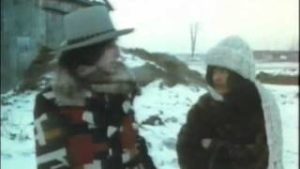
The presence of Baez appears to signify that there are many clearly autobiographical elements in the film. The climactic scenes feature a strangely surreal confrontation between Baez, Dylan and Sara – as ‘The Woman’, ‘Renaldo’ and ‘Clara’ – in which ‘Clara’ acts with extreme jealousy and possessiveness and ‘Renaldo’ makes rather vague excuses for his unfaithfulness, claiming he loves both women. Baez remains oddly serene and detached throughout. Of course, the audience knows full well that they are watching Bob Dylan, Sara Dylan and Joan Baez playing out the scene which in some way reflects what happened in real life.. If the film’s main theme is – as Dylan has stated – is that of ‘identity’, here he presents himself as being caught in the middle of a parody of his own ‘real’ life, playing with the audience’s preconceived ideas about the ‘characters’ on screen.
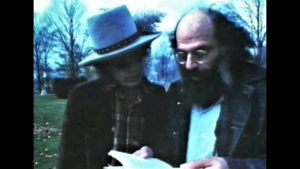
Another major presence in the film is the Beat poet Allen Ginsberg, for whom Dylan had long professed great admiration, and who appeared in the earlier gigs of the tour reading poems in between acts. He is also shown performing Blake’s Nurse’s Song on the harmonium and reading extracts from his great poem Kaddish to a bemused audience of very ‘respectable’ middle aged Jewish women, as well as leading the whole troupe in a rather hilarious faux-Buddhist ‘chanting and dancing’ scene on a beach. Ginsberg, who in later years stated publically that he regarded Dylan, rather than himself, as America’s greatest living poet, is credited as ‘The Father’. One of the movie’s most genuinely moving scenes occurs when we see Ginsberg and Dylan (dressed in his ‘Renaldo’ garb) visiting the grave of Jack Kerouac in his native town of Lowell, Massachusetts, during which Dylan (or Renaldo) declares emphatically that …I want to be buried in an unmarked grave…
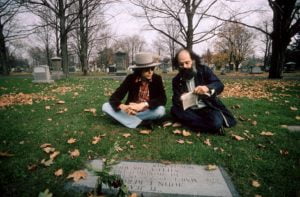
Through the ‘character’ of Renaldo Dylan thus expresses the essential ambiguity of his public persona. This was particularly pertinent in the context of the mid 70s, when his years of domestic retreat with Sara and their growing brood ended and he returned to becoming a public figure.. In the songs of Blood on the Tracks the real life anguish of the breakup of his marriage was filtered through a song cycle in which ‘fictional’ characters are depicted in various interactions from a range of different perspectives. Dylan himself once claimed that the album was in fact based on short stories by Anton Chekov. He also claimed that Sara, the explicitly autobiographical song that concludes Desire and which features prominently in Renaldo and Clara, was not about his own wife but about the Biblical wife of Abraham. Very few people, including perhaps Dylan himself, really believed such pronouncements. Always wary of those who try to treat him as a ‘celebrity’, he has always taken pains throughout his career to separate his art from his work. But there is little doubt that in much of his mid -70s work he is wrestling with the legacy of his broken marriage, an element which is virtually ignored in Scorsese’s film.
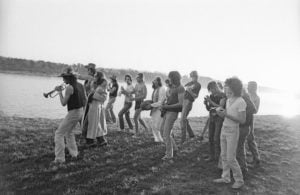
The impassioned performance of Sara in Renaldo and Clara is thus especially heart rending. Dylan may be ‘disguised’ in whiteface but the expression of passion, regret and tearful nostalgia for the lost precious moments of family life is palpable. Despite its author’s denials, this is the one song in Dylan’s catalogue which is unquestionably autobiographical, in which the barriers and ‘masks’ he adopts to separate his private life from his public persona break down. When he sings …You must forgive me my unworthiness… he is undoubtedly making a confession of his own guilt in regard to the collapse of his marriage. The power of the song is intensified by the fact that the songwriter who Baez characterised so accurately in Diamonds and Rust as …You who are so good with words/ And keeping things vague… is opening his heart in a way that he has never done before or since. The admission that he …stayed up for days in the Chelsea Hotel/ Writing ‘Sad Eyed Lady of the Lowlands’ for you… is completely ambiguous. This, for once, is undoubtedly Bob Dylan ‘himself’ speaking. The fact that he is actually publically willing to ‘confess’ that the epic climax of Blonde on Blonde, a transcendental love song full of extraordinary imagery – a song which appears to have no real beginning or ending and which ultimately describes a love so universal that it truly has ‘no limits’ – is actually directed at a real, specific person is heartbreaking in itself. Here, like the ‘President’ in It’s Alright Ma, for perhaps the only time in his career, Dylan stands naked. But there, as another confused young poet once said, lies the rub. In Sara he may dedicate Sad Eyed Lady to his wife but in fact it is extremely arguable that the earlier song is really ‘about’ Sara, despite the reference to …your magazine husband… (Sara had previously married to Hans Lownds, a magazine photographer). Very little else in this song could be said to be specifically ‘about’ one person. Ironically, perhaps the greatest cover version of Sad Eyed Lady is performed by Joan Baez on the 1968 Any Day Now album. Baez has covered many Dylan songs in her long career. Some suited the incredible purity of her voice more than others. She inhabits the song completely. Its rising and falling cadences are perfect for her crystal clear tones. It is hard to believe that in some way she did not think that at least some of the song was actually about her. While Martin Scorsese’s movie is in itself certainly one of the great rock ‘documentaries’, cleverly blurring the line between fiction and reality, Scorsese presents this efficiently as a clever ‘mind game’. In Renaldo and Clara, Dylan goes much deeper into this territory, boldly questioning our assumptions about the relationship between art and life in a way that no other film about popular music has ever done. In its own unique way, with its dreamy ambience and its ambiguities, it is like a four hour version of a great Dylan song, which encapsulates his entire personal and artistic history up to the point it was made. But it is much more than an inscrutable intellectual exercise. Behind the shifting realities it presents we see Dylan truly laying bare his heart and soul, truly – indeed- as its opening song hopes for, ‘painting his masterpiece’.

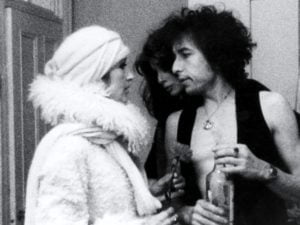

DYLAN LINKS
DAILY DYLAN NEWS at the wonderful EXPECTING RAIN
THE BOB DYLAN PROJECT- COMPREHENSIVE LISTINGS
STILL ON THE ROAD – ALL DYLAN’S GIGS



Leave a Reply